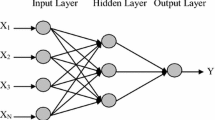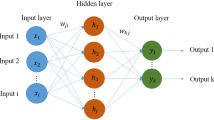Abstract
The significance of adjustment and computation studies has grown in recent years, influencing allied fields like arithmetic and satellite geodesy. This empirical study explores the effectiveness of various soft and traditional regression methods in correcting survey field data. Specifically, it investigates soft computing techniques such as back-propagation artificial neural network (BPANN), radial basis function artificial neural network (RBFANN), generalized regression artificial neural network (GRANN), and traditional regression methods like polynomial regression model (PRM) and least square regression (LSR) techniques. The study aims to fill the knowledge gap regarding soft computing strategies for modifying real-time kinematics (RTK) GPS field data and the ongoing debate between artificial intelligence techniques (ANN) and traditional methods on which technique offers the best results in modifying survey field data. Performance criteria, including horizontal displacement (HE), arithmetic mean error (AME), arithmetic mean square error (AMSE), minimum and maximum error values, and arithmetic standard deviation (ASD), were used to assess each model technique. Statistical analysis revealed that RBFANN, BPANN, and GRANN achieved superior accuracy compared to conventional techniques (PRM and LSR) in adjusting real-time kinematics GPS data. RBFANN outperformed BPANN and GRANN in terms of AME, AMSE, and ASD of their horizontal displacement. These findings suggest that soft computing techniques enhance real-time kinematics GPS field data adjustment, addressing critical issues in accurate positioning, particularly in Ghana. This study contributes to the knowledge base for developing an accurate geodetic datum in Ghana for national and local objectives. This will lay a foundation for the global determination of exact positions in Ghana. RBFANN emerges as a promising option for real-time kinematics GPS field data adjustment in topographic surveys. However, care should be taken to check issues of data overfitting.





Similar content being viewed by others
Data availability
The authors confirm that the data supporting the findings of this study are available within the article and its supplementary materials. Raw data that support findings of the study are available from the corresponding author, upon reasonable request.
References
Akcin H, Celik T (2013) Performance of artificial neural networks on kriging method in modeling local geoid. Bol Ciênc Geod 19(1):84–97
Annan RF, Ziggah YY, Ayer J, Odutola CA (2016) Accuracy assessment of heights obtained from total station and level instrument using total least squares and ordinary least squares methods. J Geomat Plan 3(2):87–92
Asenso-Gyambibi D, Lamkai N, Peprah MS, Larbi EK, Asamoah B, Okantey P (2022) Novel ellipsoidal heights predictive models based on artificial intelligence training algorithms and classical regression models techniques : a case study in the Greater Kumasi metropolitan area local geodetic reference. Int J Earth Sci Knowl Appl 3(2021):493–515
Bashirov A, Mazhar Z, Ertürk S (2008) Boundary value problems arising in Kalman filtering. Bound. Value Probl. https://doi.org/10.1155/2008/279410
Caleb M, Atayi J, Kabo-bah A, Švik M, Acheampong D (2018) Assessing the impacts of urbinization on the climate of Kumasi. May 2020. https://doi.org/10.20944/preprints201809.0059.v1
Chen W, Hill C (2005) Evaluation procedure for coordinate transformation. J Surv Eng 131(2):43–49
Dawod GM, Al-krargy EM, Amer HA (2022) Accuracy assessment of horizontal and vertical datum transformations in small-areas. GNSS Surveys in Egypt 8(1):19–28
Dudek G (2011) Generalized regression neural network for forecasting time series with multiple seasonal cycles. Springer-Verlag, Berlin Heidelberg 1:1–8
Erdogan S (2009) A comparison of interpolation methods for producing digital elevation models at the field scale. Earth Surf Process Landforms 34:366–376
Erol B, Celik RN (2005) Modelling local GPS/levelling geoid with the assessment of inverse distance weighting and geostatistical kriging methods. Greece, Athens, pp 1–5
Ghana Statistical Service (2014) Population and housing census estimates. Stats Ghana, Accra Ghana. www.ghanastatisticalservice.com
Ghilani CD, Wolf PR (2006) Adjustment computations: spatial data analysis, 4th edn. Hoboken, NJ: John Wiley & Sons
Golub GH, Van Loan CF (1989) Matrix computations, 2nd edn. Johns Hopkins University Press, Baltimore, MD, p 200
Hannan SA, Manza RR, Ramteke RJ (2010) Generalized regression neural network and radial basis function for heart disease diagnosis. Int J Comput Appl 7(13):7–13
Hornik K, Stinchcombe M, White H (1989) Multilayer feed forward networks are universal approximators. Neural Network 2:359–366
Idri A, Zakrani A, Zahi A (2010) Design of radial basis function neural networks for software effort estimation. Int J Comput Sci 4(7):11–17
Kaloop MR, Rabah M, Hu JW, Zaki A (2017) Using advanced soft computing techniques for regional shoreline geoid model estimation and evaluation. Mar Georesour Geotechnol 1–11. https://doi.org/10.1080/1064119x.2017.1370622
Kleijnen JPC (2009) Kriging metamodeling in simulation: a review. Eur J Oper Res 192(3):707–716. https://doi.org/10.1016/j.ejor.2007.10.013
Konakoglu B, Cakir L (2018) Generalized regression neural network for coordinate transformation. AIST, Montenegro, pp 66–78
Kumi-Boateng B, Ziggah YY (2020) Empirical study on the integration of total least squares and radial basis function neural network for coordinate transformation. GJSTD 7(1):38–57
Lee JM, Min KS, Min WK, Park H (2020) A study on the actively capture of road construction information using spatial analysis. J Korean Soc Cadastre 36(2):149–159
Maidaniuk I, Tsoi T, Hoian I, Doichyk M, Patlaichuk O, Stupak O (2022) The problem of artificial intelligence in contemporary philosophy. Broad Research in Artificial Intelligence and Neuroscience 13(4):436–449. https://doi.org/10.18662/brain/13.4/397
Mihalache RM (2012) Coordinate transformation for integrating map information in the new geocentric European system using Artificial Neural Networks. GeoCAD 1–9
Miller SJ (2006) Methods of least squares, statistics theory. Cornell University, USA 3:1–2
Mueller VA, Hemond FH (2013) Extended artificial neural networks: in-corporation of a priori chemical knowledge enables use of ion selective electrodes for in-situ measurement of ions at environmental relevant levels. Talenta 117:112–118
Oduro C, Kafui O, Peprah C (2014). Analyzing growth patterns of Greater Kumasi metropolitan area using GIS and multiple regression techniques analyzing growth patterns of Greater Kumasi metropolitan area using GIS and multiple regression techniques. 7(5). https://doi.org/10.5539/jsd.v7n5p13
Okwuashi O, Eyoh A (2012) Application of total least squares to a linear surveying network. J Sci Arts 4(21):401–404
Ophaug V, Gerlach C (2017) On the equivalence of spherical splines with least-squares collocation and Stokes’s formula for regional geoid computation. Springer, 1–16. https://doi.org/10.1007/s00190-017-1030-1
Osei-Nuamah I, Appiah-Adjei EK (2017) Hydrogeological evaluation of geological formations In Ashanti Region. Ghana J Sci Technol 37(1):34–50
Peprah MS, Kumi SA (2017) Appraisal of methods for estimating orthometric heights – a case study in a mine. J Geosci Geomat 5(3):96–108
Peprah MS, Mensah IO (2017) Performance evaluation of the ordinary least square ( OLS ) and total least performance evaluation of the ordinary least square ( OLS ) and total least square ( TLS ) in adjusting field data : an empirical study on a DGPS data. S Afr JGeomat 6(1):73–89. https://doi.org/10.4314/sajg.v6i1.5
Poku-Gyamfi Y (2009) Establishment of GPS reference networking Ghana. MPhil Dissertation. Universitat Der Bundeswehr Munchen Werner Heisenberg-Weg, Germany 39(85577):1–218
Ruffhead A (2012) An introduction to least-squares collocation. Surv Rev 29(224):85–94. https://doi.org/10.1179/003962687791512662
Schaffrin B (2006) A note on constrained total least square estimation. Linear Algebra Appl 417:245–258
Specht D (1991) A general regression neural network. IEEE Trans Neural Networks 6(2):568–576
Srichandan S (2012) A new approach of software effort estimation using radial basis function neural networks. ISSN (print) 1(1):2319–2526
Wang J (2014) Test statistics in Kalman filtering test statistics in Kalman filtering. June 2008. https://doi.org/10.5081/jgps.7.1.81
Yakubu I, Ziggah YY, Peprah MS (2018) Adjustment of DGPS Data using artificial intelligence and classical least square techniques. J Geomat 12(1):13–20
Yilmaz M, Turgut B, Gullu M, Yilmaz I (2017) Application of artificial of artificial neural networks to height transformation. Tehnicki Vjesnik 24(2):443–448
Yonaba H, Anctil F, Fortin V (2010) Comparing sigmoid transfer functions for neural network multistep ahead stream flow forecasting. J Hydrol Eng 15(4):275–283
Ziggah YY, Tierra A, Youjian H, Konate AA, Hui Z (2016) Performance evaluation of artificial neural networks for planimetric coordinate transformation-a case study, Ghana. Arab J Geosci 9:698–714
Ziggah YY, Youjian H, Laari PB, Hui Z (2017) Novel approach to improve geocentric translation model performance using artificial neural network. Geoid. Bol Ciênc Geod 213–233. https://doi.org/10.1590/S1982-21702017000100014
Acknowledgements
The authors appreciate the anonymous reviewers’ constructive criticism, time, and efforts in helping to make this paper better. We would also want to express our heartfelt gratitude to fellow researchers including Ing. Emmanuella Adubea Asamoah, Engr. Opuni Kwarteng, Ing. Benedict Asamoah Asante, Miss Jennifer Afumah Nyamah, and Mr. Leslie Sarpong for their advice and encouragement throughout this work.
Author information
Authors and Affiliations
Corresponding author
Ethics declarations
Conflict of interest
The authors declare that they have no competing interests.
Additional information
Responsible Editor: Biswajeet Pradhan
Rights and permissions
Springer Nature or its licensor (e.g. a society or other partner) holds exclusive rights to this article under a publishing agreement with the author(s) or other rightsholder(s); author self-archiving of the accepted manuscript version of this article is solely governed by the terms of such publishing agreement and applicable law.
About this article
Cite this article
Asenso-Gyambibi, D., Danquah, J.A., Larbi, E.K. et al. Enhancing survey field data with artificial intelligence: a real-time kinematic GPS study. Arab J Geosci 17, 184 (2024). https://doi.org/10.1007/s12517-024-11989-2
Received:
Accepted:
Published:
DOI: https://doi.org/10.1007/s12517-024-11989-2




